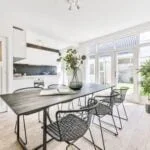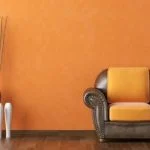Model homes play a crucial role in the real estate industry as they provide potential buyers with a tangible representation of a property’s potential. They are meticulously designed to showcase the best features of the house and help buyers visualize themselves living in that space.
But have you ever wondered who decorates model homes? Interior designers are the creative minds behind the captivating designs of model homes, bringing their vision to life and creating spaces that appeal to target buyers.
In today’s competitive real estate market, model homes serve as a powerful marketing tool for home builders and developers. They allow potential buyers to experience the lifestyle that comes with living in a particular property, ultimately influencing their purchasing decision. As such, interior designers play a pivotal role in curating an appealing and aspirational atmosphere within these model homes, using their expertise to create an environment that speaks to the desires of prospective homeowners.
Collaboration between interior designers and home builders is essential in creating model homes that effectively highlight the best aspects of a property. From concept development to final execution, interior designers work closely with home builders to ensure that the design aligns with the overall branding and marketing goals. The end result is a meticulously decorated model home that not only showcases the property’s potential but also reflects the latest trends and styles in interior design.
The Purpose of Model Homes
Model homes serve a crucial purpose in the real estate industry, providing potential buyers with a tangible representation of the property they are considering. These fully furnished and decorated spaces allow individuals to visualize themselves living in the home, which can be a powerful selling tool. Model homes are designed to showcase the best features of the property and inspire potential buyers to see the potential of the space.
Interior designers play a key role in creating model homes that effectively communicate the lifestyle and atmosphere of the property. They carefully select furniture, decor, and accessories that not only enhance the architectural features of the home but also create an emotional connection for visitors. Here are some specific ways in which model homes benefit real estate sales:
- Providing a tangible representation: Model homes give potential buyers a physical space to experience, allowing them to assess room sizes, flow, and functionality.
- Inspiring imagination: By presenting a beautifully decorated and inviting space, model homes help potential buyers envision themselves living in the property.
- Highlighting unique features: Interior designers strategically arrange furniture and decor to draw attention to special architectural elements or custom features of the home.
Ultimately, model homes play a critical role in helping real estate agents close sales by creating an enticing and relatable environment for potential buyers. The collaboration between interior designers and home builders is essential in bringing these spaces to life, as their combined expertise ensures that every aspect of the model home reflects the best qualities of the property.
The Role of Interior Designers
Interior designers play a crucial role in the real estate industry, especially when it comes to decorating model homes. These professionals are responsible for bringing the vision of the property to life and creating an inviting space that potential buyers can envision themselves living in. From choosing the right color schemes and furniture to maximizing the use of space, interior designers have a significant impact on the overall appeal of model homes.
Creating a Vision
Before any decorating takes place, interior designers work closely with home builders and developers to understand the target demographic for the property. This involves researching current market trends and understanding what potential buyers are looking for in a new home. By creating a clear vision for the model home, interior designers can tailor their designs to appeal to specific groups of buyers, whether it’s young professionals, families, or retirees.
Selection of Furniture and Decor
Once the vision is established, interior designers are responsible for selecting suitable furniture and decor that not only complements the space but also reflects the lifestyle and preferences of the target demographic. They carefully consider factors such as comfort, functionality, and aesthetic appeal to create an atmosphere that resonates with potential buyers. From coordinating fabric patterns to choosing statement pieces, every detail is meticulously planned out by interior designers.
Bringing It All Together
The role of interior designers goes beyond simply selecting furniture and decor; they oversee every aspect of decorating the model home from start to finish. This includes coordinating with contractors for any necessary renovations or installations, as well as ensuring that the final presentation aligns with the initial vision. It’s through their creative expertise and attention to detail that interior designers ultimately bring model homes to life, making them an essential part of the real estate sales process.
Collaboration With Home Builders
Understanding the Vision
When it comes to decorating model homes, interior designers must work closely with home builders to understand the vision for the property. This collaboration involves discussions, site visits, and a thorough understanding of the architectural plans and features of the home. By collaborating with home builders, interior designers gain valuable insight into the design elements that need to be highlighted in order to showcase the best features of the property.
Seamless Integration
The collaboration between interior designers and home builders is essential for ensuring a seamless integration of design and construction. By working together from the early stages of planning, both parties can align their visions and identify any potential challenges that may arise during the decorating process. This partnership allows for a cohesive approach to creating model homes that not only look aesthetically appealing but also function well for potential buyers.
Maximizing Space and Functionality
Interior designers who specialize in decorating model homes understand the importance of maximizing space and functionality. Collaborating with home builders enables them to make strategic design decisions that enhance the overall appeal of the property while also highlighting its best features. With input from home builders, interior designers can create model homes that are not only visually stunning but also practical and functional for potential buyers.
Design Process
When it comes to decorating model homes, interior designers follow a step-by-step process to bring the vision to life. This process involves careful planning, coordination with home builders, and attention to detail. Here’s a breakdown of the typical design process that interior designers go through in decorating model homes:
1. Concept Development: The first step in decorating model homes is the concept development phase. Interior designers work closely with home builders and real estate developers to understand the target market and the overall aesthetic of the property. This involves researching current design trends and styles to create a concept that appeals to potential buyers.
2. Space Planning: Once the concept is established, interior designers focus on space planning. This involves creating layouts for each room in the model home, considering factors such as traffic flow, furniture placement, and functionality. The goal is to showcase the best features of the property while ensuring that each space feels inviting and well-designed.
3. Selection of Furnishings and Décor: After space planning, interior designers move on to selecting furnishings and décor for the model home. This includes choosing furniture, accessories, artwork, lighting fixtures, and textiles that align with the established concept and appeal to the target market.
4. Installation and Styling: The final phase of the design process involves installation and styling. Interior designers oversee the implementation of their design plan, making adjustments as needed to achieve the desired look and feel. This includes arranging furniture, hanging artwork, styling surfaces, and adding finishing touches to complete the overall design scheme.
This step-by-step process ensures that model homes are expertly decorated to showcase the property’s potential and appeal to potential buyers who visit them.
Latest Trends and Styles
The interior design of model homes plays a crucial role in attracting potential buyers and showcasing the best features of a property. As a result, it is essential for decorators to stay updated with the latest trends and styles in home interior design. By incorporating current trends and styles, decorators can create model homes that appeal to target buyers and leave a lasting impression.
One of the current trends in model home interior design is the use of natural elements and sustainable materials. With an increasing focus on environmental consciousness, many decorators are incorporating eco-friendly elements such as reclaimed wood, natural stone, and organic textiles into their designs. This not only enhances the aesthetic appeal of model homes but also appeals to environmentally conscious buyers who are seeking sustainable living spaces.
In addition to sustainability, contemporary model home designs often feature open floor plans, minimalistic decor, and neutral color schemes. These elements create a sense of spaciousness and tranquility, allowing potential buyers to visualize themselves living in the space. Decorators carefully select furniture, accessories, and artwork that align with these modern aesthetics to create a cohesive and visually appealing interior design scheme.
Moreover, there has been a growing demand for smart home technology in model homes. Many decorators are integrating state-of-the-art smart devices and systems into their designs to showcase the convenience and efficiency of modern living. From automated lighting and climate control to voice-activated assistants, these technological features add value to the model homes and cater to tech-savvy buyers.
With these emerging trends in mind, decorators play a vital role in creating inviting and trend-forward model homes that resonate with potential buyers.
| Current Trends | Impact on Model Home Interior Design |
|---|---|
| Natural Elements & Sustainable Materials | Enhances aesthetic appeal and appeals to environmentally conscious buyers |
| Open Floor Plans & Neutral Color Schemes | Create a sense of spaciousness and tranquility for potential buyers |
| Smart Home Technology | Showcases convenience and efficiency of modern living for tech-savvy buyers |
Budgeting and Resource Management
Model home decorating is not just about creating a visually appealing space; it also involves effective budgeting and resource management. Interior designers who decorate model homes play a crucial role in making the most of their resources to bring the vision to life while staying within budget constraints. They are responsible for carefully planning and allocating the budget for each aspect of the project, from furniture and decor to lighting and accessories.
One of the key aspects of budgeting and resource management in decorating model homes is the ability to find high-quality, yet affordable, decor and furnishings. Decorators must have a keen eye for sourcing items that strike a balance between cost-effectiveness and aesthetic appeal. This often involves building relationships with vendors, negotiating prices, and keeping abreast of industry trends to make informed purchasing decisions.
In addition to managing costs, decorators must also work with the resources available to them in an efficient manner. This may involve repurposing existing furniture or decor, using versatile pieces that can be used in multiple settings, or implementing creative DIY solutions. By making strategic choices on how to utilize their resources, interior designers are able to create stunning model homes that captivate potential buyers without overspending.
Success Stories and Case Studies
Model homes play a crucial role in the real estate industry, providing potential buyers with a tangible vision of the available space. However, it is the interior designers who are responsible for transforming these empty houses into inviting and aspirational spaces that capture the imagination of potential buyers. It is these skilled professionals who decorate model homes, using their expertise to create an environment that not only looks stunning but also effectively showcases the best features of a property.
One successful case study is the collaboration between renowned interior designer, Jane Smith, and a leading home builder in creating a model home for a new residential community. By incorporating the latest design trends such as open-concept living spaces and natural light, Jane was able to transform the space into a modern and inviting environment.
The result was a significant increase in interest from potential buyers, leading to quicker sales and higher selling prices for the properties within the development.
Another example is the work of interior designer John Doe, who teamed up with a luxury home builder to create an exclusive model home in an upscale neighborhood. With careful attention to detail and high-end finishes, John was able to elevate the property’s appeal among discerning buyers. As a result, the model home became a showcase for the builder’s craftsmanship and attention to quality, ultimately driving faster sales and setting a benchmark for future projects.
The success stories of these decorating projects illustrate how interior designers play a vital role in influencing potential buyers and ultimately contributing to the sales success of real estate properties.
| Successful Model Home Project | Interior Designer | Home Builder |
|---|---|---|
| New Residential Community | Jane Smith | Leading Home Builder |
| Upscale Neighborhood | John Doe | Luxury Home Builder |
Conclusion
In conclusion, the process of decorating model homes is crucial in the real estate industry as it plays a significant role in attracting potential buyers and helping them visualize their future space. Interior designers are the ones responsible for creating these stunning living spaces, working closely with home builders to showcase the best features of the property.
The collaboration between interior designers and home builders results in model homes that not only reflect current trends and styles but also appeal to target buyers.
The impact of model home decorating goes beyond just aesthetics; it directly contributes to the success of real estate properties. By creating inviting and stylish spaces, decorators help potential buyers see themselves living in the property, ultimately leading to increased sales.
Success stories and case studies have shown how well-decorated model homes have significantly influenced the decision-making process of potential buyers, making them more likely to invest in a property that they can connect with on an emotional level.
In essence, model home decorating is an art form that combines creativity, strategic thinking, and resource management. It not only showcases the possibilities of a space but also creates value for both home builders and potential buyers. As the real estate industry continues to evolve, so will the role of decorators who play a vital part in shaping the future of model homes and influencing buyer decisions.
Frequently Asked Questions
What Do Model Home Designers Do?
Model home designers are responsible for creating the overall look and feel of a model home to showcase the builder’s floor plan and features. They select furniture, furnishings, and decor to appeal to potential buyers.
What Do You Call Someone Who Decorates Houses?
Someone who decorates houses is commonly referred to as an interior designer or interior decorator. These professionals work with clients to create cohesive, functional, and aesthetically pleasing living spaces that suit their needs and style preferences.
How to Decorate a Model Home?
Decorating a model home involves carefully selecting furniture, decor, and accessories that highlight the best features of the space. Designers often use neutral color palettes, minimalistic styling, and strategically placed accents to create a welcoming and appealing environment for potential buyers.
The goal is to make it easy for visitors to envision themselves living in the space while showcasing its full potential.

I’m thrilled to be your companion on this exciting journey through the world of home decor and design. With a passion for turning houses into homes and a keen eye for the finer details, I’m here to help you transform your living spaces into beautiful, functional, and meaningful havens.





